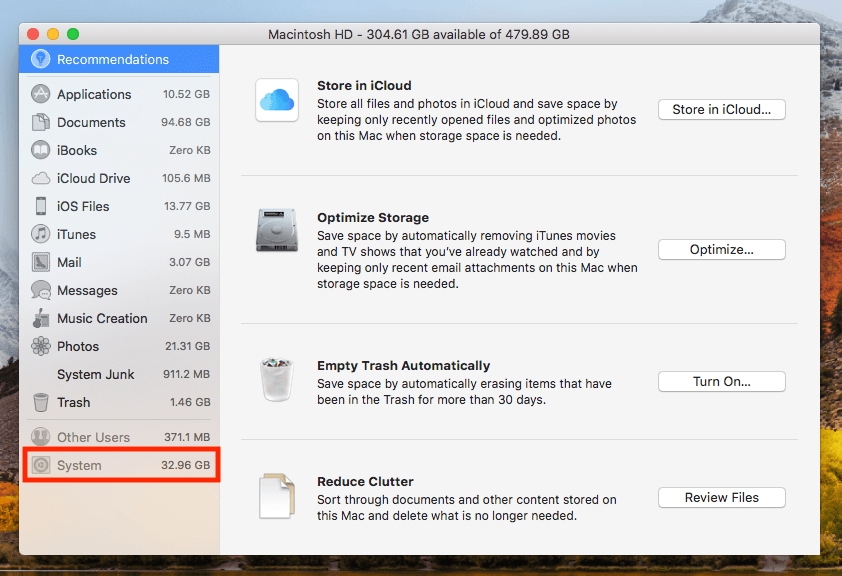What is 'Other' and What Can I Do About It?
'Other' on your iDevice
- Remove app plugins and extensions from Other storage. Another cool way to manage storage on Mac. While apps are, unsurprisingly, categorized as Apps on the Storage bar, their add-ons are under the Other storage category. Compared to some types of files, app plugins and extensions probably won’t take up as much of your Mac's Other space.
- Select the hard drive from the list. The Disk Utility window will show you the hard drive capacity, used space and available space, drive type, and other information. Refer to About This Mac. How to view storage on Mac directly: Go to the Apple menu (presented by an Apple icon). Select About This Mac from it. Shift to the Storage tab at the top.
- Click the “Show items in a list” icon on the toolbar and then click the Size heading to sort your installed applications by size. Clean Up the Huge iTunes Backups of Your iPhone or iPad If you’ve backed up your iPhone or iPad to your Mac using iTunes, you’ve probably got a bunch of massive backup files that are taking up a shocking.
MiTeC System Information X is a free system information software program that's licensed for both private and commercial use. The tool is portable, easy to use, and can create a summary report. Among many other categories, you'll find all the standard details like audio, network, and motherboard, information.
When you connect your iPad, iPod Touch, or iPhone to your computer and open iTunes, you will find a graph of the space usage that may look like this:

Note the category at the end called 'Other.' What is 'Other?' iTunes has 8 standard data categories listed in the Data Bar of iTunes. They are called Apps, Music, Movies, TV Shows, Podcasts, Books, Photos, and Info. Basically, anything stored on your iDevice that cannot fit into one of those 8 categories is categorized as 'Other.' This includes:

As you can see there's a lot of stuff that ends up in 'Other.' If you never clean up things the stuff accumulates like old toys in an attic. Soon you find half the space on your iDevice is taken up by 'Other.' This is not good. You want to clean things out. So here's how you do it:

'Other' on Your Computer
On your Mac you may also see an 'Other' reported when you check on your drives using About This Mac from the Apple () menu.
When you observe the Storage display via the About This Mac dialog you will see something like this:
Note the similarity to what you might find on your iDevice. There are 5 data categories: Audio, Movies, Photos, Apps, and Backups. Anything else is categorized as 'Other.' 'Backups' refers to Time Machine Snapshots that are made when the Time Machine backup drive is not available. When the backup drive is finally reconnected, Time Machine is supposed to transfer the snapshots to the Time Machine backup drive then erase the ones on your hard drive. 'Apps' only include those found in your Applications folder. Thus, 'Other' consists of some of the same types of files found on your iDevice:

System Information Is Showing 0kb Of Storage In Apps Macbook
This is really a short list of what is categorized as 'Other' because it does not fit into any of the other 5 categories.
The problem is you cannot go searching out just any old files on your hard drive and deleting them. If you do you may find that your OS X system no longer works. This could lead to a lengthy reinstallation or even to erasing the hard drive and starting over from scratch. No, this is a process that requires some delicacy and finesse. Firstly, you should search your drive for large files and where they are located. Use a utility such as OmniDiskSweeper 1.8 or GrandPerspective.
Secondly, follow suggestions below for cleaning up your hard drive of unnecessary files taking up space on your hard drive.
Freeing Up Space on The Hard Drive
System Information Is Showing 0kb Of Storage In Apps Macbook Pro
Empty the Trash in order to recover the space the files occupied on the hard drive. If you cannot free up enough space, then you should consider replacing the drive with a larger one. Check out OWC for drives, tutorials, and toolkits.
System Information Is Showing 0kb Of Storage In Apps Mac
Thirdly, locate any duplicate files on your hard drive and delete them. You can use one of several utilities designed to locate duplicate files such as:
System Information Is Showing 0kb Of Storage In Apps Mac Os
System Information Is Showing 0kb Of Storage In Apps Machine
Hopefully, this discussion will put an end to any concerns you've had about 'Other.'